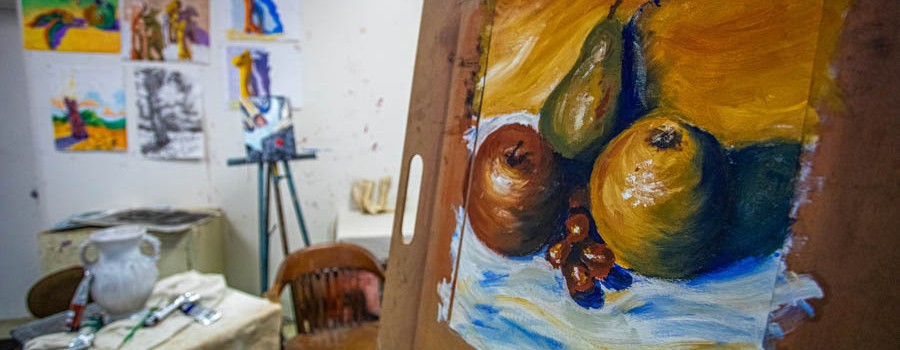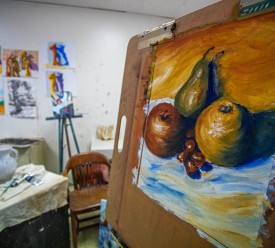Ignite creativity in future artists!
Art, a conduit for emotion, a beacon in darkness, a showcase of skill, a source of hope, and a catalyst for joy. Make a difference by imparting the gift of art to the upcoming generation!
If you possess a love for children and a fervor for art, University of the Cumberlands’ Art Education Program is tailor-made for you. This program provides a robust foundation aligned with your future aspirations and career objectives. Explore a spectrum of artistic techniques and mediums, challenging yourself under the mentorship of faculty members who themselves excel as accomplished artists.
Our Art Education Degree program offers a comprehensive education merging the traditional and innovative, grounded in a robust liberal arts framework. Upon graduation, you'll be equipped with certification essential for pursuing impactful art education opportunities, empowering you to shape and influence the next wave of young artists!
Programs & Requirements
* The credit hours listed on this page only reference the specific program requirements and is not reflective of the total hours necessary to receive your degree. Cumberlands requires all students obtain a minimum of 60 hours for an associate’s degree and a total of 120 hours for a bachelor’s degree. Transfer and prior learning credits may be counted toward those totals.
To learn more about our General Education Requirements, please visit the page referenced below or explore our Academic Catalog.
Bachelor of Science with a Teaching Major in Art
Want to study art and pass on this knowledge and appreciation to the next generation? This program will equip you with everything you need to do just that! You’ll study the history of art and learn about great artists of the past and present. You’ll also get hands on experience with the craft, working with different mediums such as drawing, painting, design, and more, to develop your own artistic talent! You’ll combine courses like these with education courses that will give you the tools you need to effectively teach young people and influence their view of art and the world forever.
Course Requirements
9 hours of Art electives at the 300 or 400 level.
Students seeking secondary certification must also take 42 hours of professional education courses.
A Bachelor of Arts requires all the same courses as a Bachelor of Science with the addition of four classes (12 hours) in a foreign language.
Choose one foreign language sequence:
- FREN 131 Elementary French I
- FREN 132 Elementary French II
- FREN 231 Intermediate French I
- FREN 232 Intermediate French II
- SPAN 131 Elementary Spanish I
- SPAN 132 Elementary Spanish II
- SPAN 231 Intermediate Spanish I
- SPAN 232 Intermediate Spanish II
Take the Next Step
Mission & Goals
The purpose of the art education degree program at UC is to prepare you to pursue a fine arts career and obtain a teaching certification. We’re here to help you develop your unique artistic style and teach you to be a competent and caring educator.
Art Education Careers & Outcomes
All stats from U.S. Bureau of Labor Statistics
High School Art Teacher: $61,620
High School Art Teacher: $61,620
As a secondary art teacher, you will mostly work in high schools, teaching art to older students, creating safe and productive classroom environments, organizing learning activities for students, upholding school rules, giving and grading assignments, and supervising students, all while instilling in them an appreciation for art.
Elementary Art Teacher: $61,350
Elementary Art Teacher: $61,350
Description: As an elementary art teacher, you will mostly work in elementary schools, preparing lessons for elementary-aged students, teaching drawing, painting, photography and other studio arts, helping uphold school rules, moderating behavior of students in the classroom, and instilling aesthetic appreciation in children early on.
Curriculum Designer: $63,740
Curriculum Designer: $63,740
As a curriculum designer, you will work behind the scenes, creating the lessons, materials, and learning plans that teachers and students will use in the course of their art education. You’ll use your skills to create curriculums and ensure their success.
Recreational Art Therapist: $47,940
Recreational Art Therapist: $47,940
As an art therapist, you will use your knowledge of the art world from your degree in art education and combine it with a master’s degree so you can apply these skills to helping individuals by using art as a therapeutic and healing process.
Museum Educator: $50,120
Museum Educator: $50,120
As a museum educator, you’ll have the opportunity to work in art museums and galleries, hosting lectures and workshops, teaching museumgoers about exhibits, artifacts, and art history, while working alongside curators, owners, and prominent artists in your community.
Art Director: $100,890
Art Director: $100,890
If you’re interested in art education but want a career outside the classroom, this could be a good option for you. As an art director, you will have opportunities to work with magazines, newspapers, movie and tv productions, product packaging, and more, helping these companies to create aesthetically pleasing images and curating visual style.
Common Questions
An art education degree prepares individuals to teach art in schools while developing their own creative skills. It combines art techniques, lesson planning, classroom management, and the required courses for certification. Graduates are trained to inspire and educate future generations of artists.
The bachelor's degree in art education at University of the Cumberlands requires a minimum of 120 credit hours, which typically takes four years to complete. This includes general education and art-focused coursework, along with teaching certification requirements.
The content provided highlights that the art education program at the University of the Cumberlands is on-campus. For those seeking online programs, it’s best to check with other institutions to explore online learning options in art education.
An art education degree is valuable for those passionate about art and teaching. It equips graduates to pursue careers as art teachers, curriculum designers, or even museum educators, with the potential to earn an average salary of $61,620 as a high school art teacher. It also opens doors to other creative roles in education and beyond.
With an art education degree, you can become an art teacher in elementary, middle, or high schools. Other career options include working as a curriculum designer, art therapist, museum educator, or art director. These roles allow you to apply your knowledge of art in various professional settings.
To get an art education degree, you need to complete a bachelor's program in art education, which includes coursework in both art and pedagogy. At University of the Cumberlands, the program also includes courses required for teaching certification by the Kentucky Department of Education.
Yes, a degree in art education is worth it for individuals passionate about teaching and creative expression. It provides the skills necessary for various career opportunities in the art world, including education, therapy, and leadership roles in creative industries.
The best degree for an art teacher is a bachelor's degree in art education. This program not only focuses on building artistic skills but also equips graduates with the teaching methodologies and certification necessary to educate students in art.
Rachel Wade"As an art student at UC, I’ve learned not only how to express my passion as an artist, but to see every artistic and beautiful aspect of the world around us."
Title / Department
Faculty Experts
Learn more about our art and education professors!

Dr. Lauren Prochak

Serena Anderson

Dr. Andrew Alexson
Request Information
Have questions? We get it. Send us a message, and we'll help you out as soon as possible!

